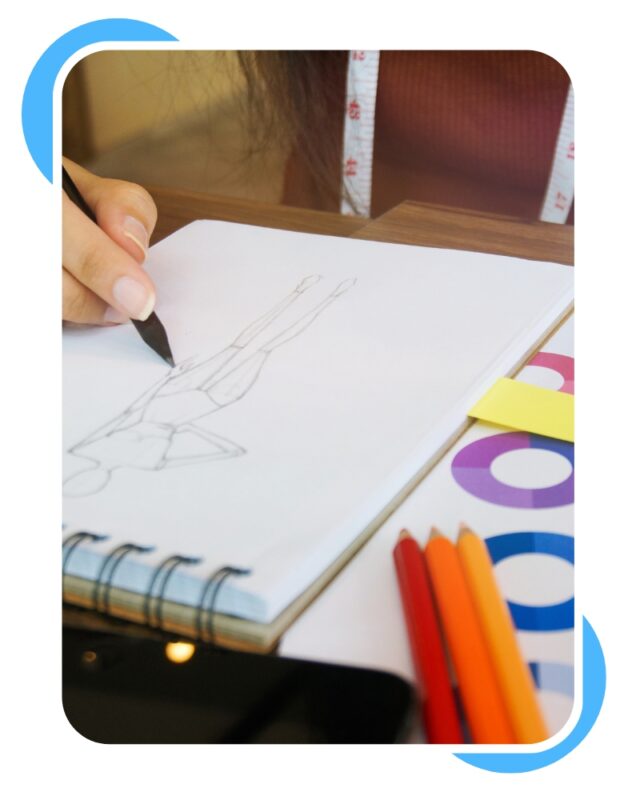
Fashion design is a creative and dynamic field that involves the design, production, and marketing of clothing and accessories. It is an industry that constantly evolves, driven by ever-changing trends, new technologies, and innovative materials. Fashion designers are responsible for creating new designs, developing patterns, and overseeing the production process to ensure that their vision is translated into high-quality garments that meet the needs and desires of consumers. They must also stay abreast of trends in the industry, market demands, and the preferences of their target audience to create clothing that is not only stylish but also functional and comfortable. In short, fashion design is an exciting and challenging profession that requires a combination of artistic talent, technical skill, and business acumen.

How To Learn Fashion Design?
Fashion design is a challenging and exciting field that requires a combination of creativity, technical skills, and business savvy. Whether one is interested in pursuing a career in fashion or wants to develop their skills as a hobby, there are several ways to learn fashion design. From online courses and university programs to bootcamps and self-study, each approach has its own advantages and challenges. By exploring these different options and finding the one that best suits one’s learning style and goals, anyone can begin their journey to becoming a skilled and successful fashion designer.
Online Courses
Many online platforms offer fashion design courses that can be taken anywhere worldwide. These courses may be self-paced or instructor-led and can cover a wide range of topics, from basic sewing skills to advanced pattern-making techniques. Online courses can be a convenient and affordable way to learn fashion design, but they may need more hands-on experience and personalized feedback that comes with in-person instruction.
University Courses
Many universities offer degree programs in fashion design, which provide a comprehensive education in the field. These programs typically include courses in design theory, garment construction, pattern-making, textile science, and business skills. University courses can provide students with a solid foundation in fashion design and may offer opportunities for internships and industry connections, but they can also be expensive and time-consuming.
Bootcamps
Fashion design bootcamps are intensive, short-term programs that aim to provide students with the skills and knowledge needed to jumpstart a career in the field. These programs may be offered in-person or online and can cover sketching, draping, sewing, and marketing topics. Bootcamps can be a fast and focused way to learn fashion design, but they may not provide the depth of knowledge and industry connections that come with a degree program.
Self-Study
Fashion design can also be learned through self-study, using books, online tutorials, and other resources. This approach requires high motivation and discipline, but it can be a flexible and affordable way to learn at one’s own pace. However, self-study may provide a different level of feedback and critique than in-person instruction or structured courses.

Benefits of Learning Fashion Design
There are many benefits to learning fashion design, whether one is interested in pursuing a career in the field or simply wants to develop their skills as a hobby. Here are some of the key benefits:
Creativity
Fashion design is a highly creative field allowing individuals to express their unique style and artistic vision. Learning fashion design can unlock one’s creativity and help them to develop their own personal design aesthetic.
Self-Expression
Fashion design allows individuals to express themselves through their clothing choices and design creations. Individuals can create clothing that reflects their style and identity by learning fashion design.
Entrepreneurship
Fashion design can be a gateway to entrepreneurship, as individuals can start their own fashion brands and businesses. By learning the skills and knowledge needed to create and market their own designs, individuals can launch their own successful fashion ventures.
Industry Connections
Learning fashion design can allow individuals to network and connect with others in the industry, from fellow designers to industry professionals. Building these connections can lead to collaborations, mentorship, and career opportunities.
Overall, learning fashion design can provide individuals with a range of benefits, from unlocking their creativity and self-expression to developing valuable skills and launching their own businesses.

Career After Learning Fashion Design
Learning fashion design can lead to various career opportunities within the fashion industry. Here are some of the most common career paths for individuals who have learned fashion design:
Fashion Designer
A fashion designer creates original clothing, footwear, and accessories designs. They may work for a fashion house or brand or launch their own fashion line.
Pattern Maker
A pattern maker creates patterns for clothing based on a designer’s sketches or specifications. They may work for a fashion brand or as a freelancer.
Fashion Illustrator
A fashion illustrator creates sketches and illustrations of fashion designs. They may work for fashion magazines, advertising agencies, or fashion brands.
Fashion Buyer
A fashion buyer selects and purchases clothing and accessories for a retail store or fashion brand. They must have a keen understanding of fashion trends and consumer preferences.
Fashion Merchandiser
A fashion merchandiser plans and coordinates the presentation of clothing and accessories in retail stores or fashion brands. They must have a strong understanding of marketing and consumer behaviour.
Fashion Stylist
A fashion stylist selects and coordinates clothing and accessories for photo shoots, fashion shows, and other events. They must have a strong sense of style and fashion trends.
Textile Designer
A textile designer creates original designs for fabrics and textiles used in fashion and other industries. They must have a strong understanding of color theory, pattern design, and textile production.
Learning fashion design can open up many career opportunities within the fashion industry, from designing clothing and accessories to marketing, merchandising, and textile design.

Salary After Learning Fashion Design in India
The salary range for Fashion Designers in India with less than 1 year of experience to 8 years ranges from ₹ 0.3 Lakhs to ₹ 7.2 Lakhs with an average annual salary of ₹ 3.3 Lakhs based on 5.9k latest salaries.

How to Succeed in a Fashion Design
If you’re interested in pursuing a career in fashion design, here are some tips to help you succeed:
Build your Skills
To become a successful fashion designer, you need to have a strong foundation in design, sewing, and pattern making. Take classes or seek out mentorship to develop your skills.
Develop your own Style
Create a unique style that sets you apart from other designers. This will help you stand out and attract clients who appreciate your aesthetic.
Network
Attend fashion events with other designers, models, photographers, and industry professionals. This can help you build relationships and create opportunities for collaboration and exposure.
Stay Current
Stay up-to-date with the latest fashion trends and technologies. Read fashion magazines, attend trade shows, and watch social media to stay current in the industry.
Be Business-Savvy
To succeed in fashion design, you need to understand the business side of things well. Develop your marketing and financial management skills, and create a strong business plan.
Be Resilient
The fashion industry can be tough, so you need to be prepared to handle rejection and criticism. Stay positive, learn from your mistakes, and keep pushing forward.
Embrace Sustainability
The fashion industry is increasingly focused on sustainability, so consider ways to incorporate eco-friendly practices into your designs and business operations. This can also help you appeal to environmentally conscious clients.
Common Challenges in Learning Fashion Design
Learning fashion design can be an exciting and rewarding experience but can also come with challenges. From mastering new techniques to staying on top of the latest trends, aspiring fashion designers may encounter a variety of obstacles along the way. In this article, we will explore some of the common challenges in learning fashion design and offer tips for overcoming them. Whether you’re a beginner or a seasoned designer, these insights can help you navigate the world of fashion design and achieve your creative goals.

Advantages and Disadvantages of Fashion Design.
Fashion design is a dynamic and creative field that offers many advantages for those passionate about style and design. From the opportunity to express artistic talents to the potential for lucrative job opportunities, fashion design can be an advantageous career choice. However, like any profession, aspiring fashion designers should be aware of certain disadvantages. In this article, we will explore the advantages and disadvantages of fashion design to help you determine whether this field is right for you.
Advantages of Fashion Design:
- Creativity: Fashion design is a highly creative field that allows designers to express their artistic talents through clothing and accessories.
- Job opportunities: There is always a demand for talented fashion designers, which means that there are plenty of job opportunities available in this industry.
- Personal satisfaction: Designing clothes people love to wear can be incredibly rewarding and satisfying for a fashion designer.
- Networking: Fashion designers often have the opportunity to network with other professionals in the industry, such as photographers, models, and makeup artists.
- Diversity: Fashion design is a diverse field that offers a range of opportunities for designers to specialize in different areas, such as haute couture, ready-to-wear, or accessories.
Disadvantages of Fashion Design
- Competition: The fashion industry is highly competitive, which means that designers must be constantly on top of the latest trends and constantly improving their skills to stay ahead of the game.
- Long hours: Fashion designers often work long hours, especially during peak seasons like Fashion Week, which can be physically and mentally exhausting.
- Financial instability: Starting a career in fashion design can be financially risky, as it can take time to establish oneself in the industry and build a stable client base.
- Criticism: Fashion designers must be prepared to handle criticism, as their designs will be judged by the public, fashion critics, and other professionals in the industry.
- Pressure: The pressure to produce new and innovative designs can be intense, and designers may need help to balance the demands of their job with their personal life.

FAQs Related to Fashion Design
Sure, I would be happy to help! Here are some frequently asked questions related to Fashion Design:
Here are some frequently asked questions (FAQs) related to fashion design:
Some essential skills for a fashion designer include creativity, an eye for detail, strong sewing skills, and knowledge of fashion trends and textiles. Business skills, such as marketing and financial management, are also important for success in the industry.
Many fashion designers have a degree in fashion design, although some are self-taught or have a background in another area of design. A degree in fashion design typically takes 2-4 years to complete.
Fashion designers can work in a variety of roles, including designing for haute couture, ready-to-wear, or accessories. Other career opportunities in fashion design include textile design, fashion merchandising, and fashion marketing.
The fashion industry is highly competitive, which can make it difficult for aspiring designers to establish themselves in the field. Fashion designers also need to be prepared to handle criticism and work long hours, particularly during peak seasons like Fashion Week.
The fashion industry is constantly evolving, with new technologies and sustainable practices shaping the future of fashion design. In the coming years, we can expect to see more emphasis on sustainability, inclusivity, and technology in the fashion industry.
